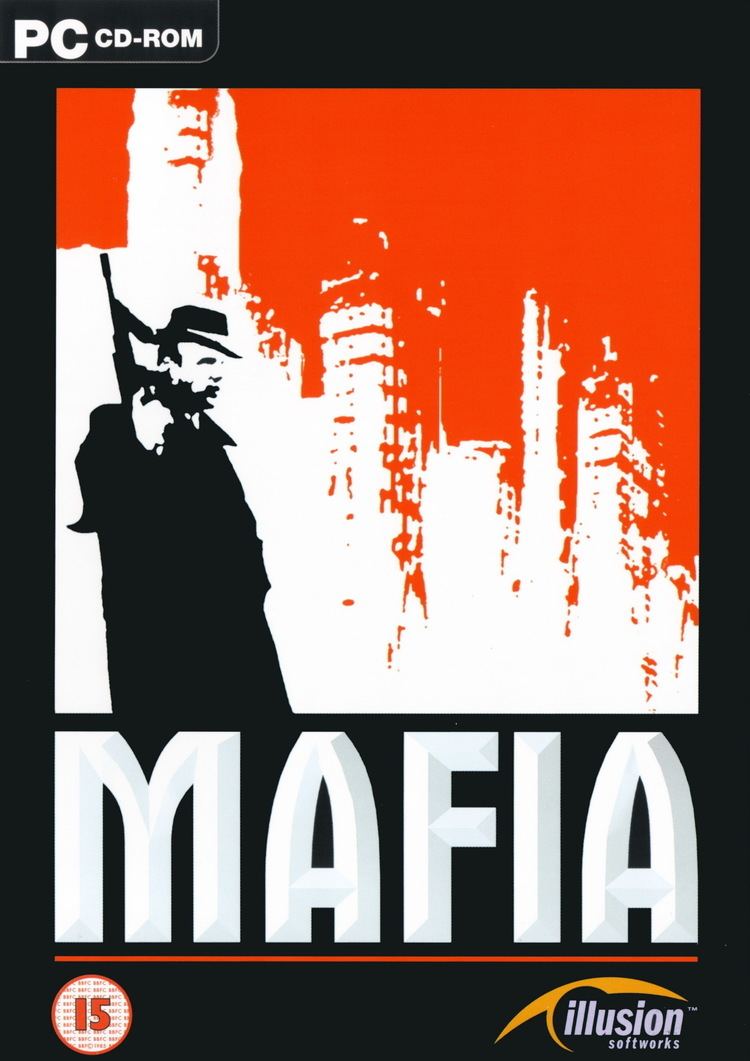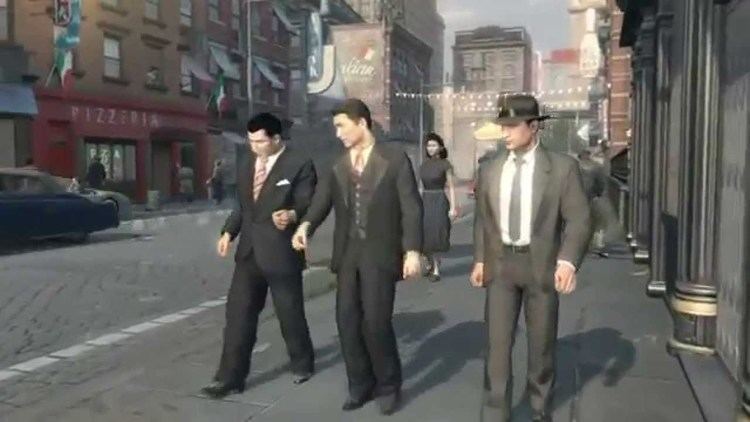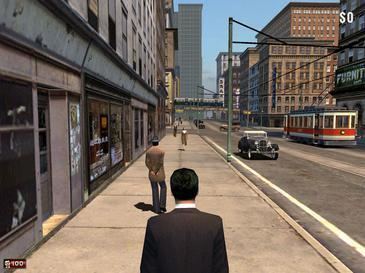Producer(s) Lukáš Kuře Artist(s) Pavel Čížek Genre Action-adventure game | Director(s) Daniel Vávra Programmer(s) Dan Doležel Writer(s) Daniel Vávra | |
 | ||
Similar 2K Czech games, Third-person shooter games | ||
Mafia is an open world action-adventure video game developed by Illusion Softworks and published by Gathering of Developers. The game was released for Microsoft Windows in August 2002, and later ported to the PlayStation 2 and the Xbox consoles in 2004, in North America and Europe. The game traces the rise and fall of Tommy Angelo, a fictional mafioso in the 1930s.
Contents

Mafia received positive reviews for the Windows version, with critics praising the game for its realism, while the PlayStation 2 and Xbox versions of the game received mixed reviews. A sequel, Mafia II by 2K Czech, was released in August 2010, and a third game titled Mafia III by Hangar 13 was released in October 2016.

Setting

Mafia is set during the 1930s in the fictional American city of Lost Heaven, with a countryside encompassing 12 square kilometers in the game. The city incorporates parts of San Francisco and Chicago of the same time period.
Plot

In 1938, on the run from his former allies, mobster Tommy Angelo meets with his police contact, Detective Norman, in a restaurant and agrees to testify against his boss, Don Salieri, in return for witness protection. A flashback to 1930 shows Tommy, who was a taxi driver, being strong-armed into helping Salieri's men escape from an ambush planned by the Morello family. The next day, two thugs try to kill him but are gunned down when he lures them to a Salieri-owned bar. As repayment, Tommy is recruited as an associate, working alongside made men Sam and Paulie. In 1932, the restaurant's bartender, Luigi, informs Tommy that strange men have been harassing his daughter Sarah. Tommy, then, passes on the information to Salieri. This not only outrages him because of their inappropriate behavior towards Sarah, but also because those same men have been causing trouble in Salieri's territory by scaring away innocent people. So, as a message from Salieri, he sends Tommy and Paulie to scare the punks off. But they end up killing one of their leaders after a car chase, who turns out to be the son of a prominent city councilor. Salieri's consigliere, Frank, then sends Tommy to plant a bomb in one of Morello's brothels and eliminate an informant within their ranks. After learning that the informant is Sarah's close friend Michelle, Tommy spares her life and sends her out of the city. He subsequently marries Sarah, and she gives birth to a daughter, whose name is never revealed throughout the game.

The following year, in 1933, while collecting a shipment of whiskey for bootlegging, Tommy, Paulie, and Sam are attacked by policemen on Morello's payroll, barely escaping with their lives. The next day, Frank sells Salieri out by providing evidence of money laundering to the authorities; Salieri orders Tommy to kill him. At the airport, Frank explains that he betrayed Salieri to protect his family and tells Tommy where to find the evidence. In return, Tommy allows Frank to fake his death and flee to Europe. Two years later, he saves Salieri from an assassination attempt by his traitorous bodyguard Carlo. In retaliation, Salieri and Tommy go to Carlo's apartment and has Tommy kill him. Sometime later, Salieri has Morello's underboss and brother Sergio killed, as well as a city councilor in his pocket. With his rival's power weakened, Salieri has Morello, himself, killed and seizes his territories.

In 1938 (months before Tommy meets with Detective Norman) the increasingly ambitious Paulie asks Tommy and Sam to help him rob a bank without Salieri's permission. Initially, Tommy chooses not to go along with the plan, as does Sam, saying that the family's pretty important to him. However, Sam doesn't reveal to either of them that he's going to tell Salieri about their plan. While doing a job for Salieri, where he wanted them to take crates filled with cigars to his warehouse, Tommy and Paulie learn that those crates are actually filled with a cache of smuggled diamonds. They discover this, while Sam goes to go pick up Salieri, and drive him to the warehouse to check the crates out. Paulie claims that Salieri intended to keep the diamonds for himself. So, after guessing this, Tommy decides to go along with Paulie on the bank job. The robbery was successful. However, the day after the event, when Tommy goes to take his share of the cash, he finds Paulie dead in his apartment. The phone rings, and Tommy answers. It's Sam. Tommy has him know about Paulie's death. Then, Sam tells Tommy to meet him at the local art gallery, where he reveals that Salieri was aware of Tommy and Paulie's disobedience and has ordered Sam to execute them. However, it wasn't only the bank job that outraged Salieri. But, he also learned that Tommy never killed Frank, nor Michelle. After capping off Sam's men, and leaving Sam, himself, severely wounded, he has Tommy know that even though Frank lived after the ordeal in 1933, he was eventually found and killed. The same with Michelle. After Sam says, "Friendship ain't worth shit", Tommy unloads his gun onto Sam, finally killing him. Then, Tommy flees the gallery.
The story returns to the present, 1938 (months after the bank job and the art gallery massacre) with Detective Norman agreeing to help out Tommy and his family. So, members of the Salieri gang were convicted and imprisoned (some of them, the death penalty) and the proper verdict for Don Salieri, himself, was life imprisonment. Then, years later in 1951, on the other side of the U.S., an elderly Tommy waters the grass outside his house, just as made men Vito Scaletta and Joe Barbaro (the protagonists of Mafia II) pull up in a car in front of his house. They get out and approach Tommy. They address him by his real name, which was changed beforehand by the FBI. However, Tommy responds by saying, "Uh...yes?" and Vito Scaletta says that Mr. Salieri sends his regards. Then, Joe Barbaro, with a sawed-off shotgun, kills Tommy. The two men get back in the car, and drive off. As Tommy lays dead on the grass, he laments how he and his friends only wanted the good life but ended up with nothing at all.
Gameplay
Mafia's storyline gameplay consists of driving, mainly easy city cruise between different locations, as well as chases and races; the rest of the game is based on third-person on-foot navigation and shooting - all inter-connected with cutscenes. In addition to city and countryside, detailed interiors like the city's airport, a museum, a church, a hotel, an abandoned prison, restaurants and Don Salieri's bar are included. Weather changes and day/night cycles are in use, though unlike in Grand Theft Auto missions take place at a set time and the weather is fixed during the duration of the level.
51 classic American cars around the city can be driven in Mafia, plus 19 bonus cars (5 of which are racing models) unlockable after the main mode and the opening of a new game mode. Cars are introduced periodically - in the beginning of the game, early 1920s models drive on the streets of the city, while models from 1930 begin appearing in later game stages. All of the vehicles are based on real-world cars from the era, albeit renamed and redesigned due to copyright issues.
Police book players for minor offenses such as speeding or running a red light, and car accidents cause physical harm to the driving player. While other forms of transport are available, such as trams and elevated rails, they are only ridable and not drivable by the player.
Mafia is noted for having comprehensive damage physics on nearly all vehicles, even going so far as to make use of real-time deformation, compared to vehicles in other games that used pre-made damage models. While substantially more robust than their real counterparts, smaller and weaker vehicles stand less abuse before breaking down and finally exploding, than large armoured vehicles. More realism is added here compared to other games in the same genre, such as the ability to puncture the fuel tank, overheat the engine, and the ability to break transmission gears. Many exterior components (such as windows, tires, headlights, and bumpers) can be removed from most vehicles with physical means such as crash-driving, hitting with blunt weapons (fists, baseball bat) as well as firing weapons at them.
Finishing the main storyline unlocks the "Freeride Extreme" mode, which is essentially the same as Freeride, but with the added benefit of stunt jumps, side quests, and the lack of police patrols. Side missions in this mode range from the trivial, such as carrying packages or killing gangsters, to the extreme and sometimes outlandish, like chasing an alien spaceship or driving an explosive-rigged truck at a certain speed.
Law and order
The police department in Lost Heaven uphold the various laws that have been set. When these laws are broken in view of the police, they will respond by booking the player with offenses that can be "minor" or "serious". Minor offenses (such as speeding in a vehicle or running a red light) will end up with the player being fined (-$1.000 in Freeride mode, no monetary value in campaign mode), and serious offenses (such as physical assault, or visible display of a weapon) can lead to the player being arrested for the first offense, or a shootout with the police. A series of four successive minor offenses qualify as a "serious" offense. Police force increases with the severity of the player's disregard of the law to a point where police, now well armed, form blockades with tire spike strips in attempt to defeat the player while firing from behind their cars.
Certain acts which would catch police's attention in real life do not in the game, such as driving on the sidewalk or on the wrong side of the road. The police AI do not recognize computer AI violations. In freeride, the police will ignore violent actions against the player. Certain motorists in the game will resist with violence if the player attempts a carjacking. The AI of these motorists does not differentiate between the player and police officers in active pursuit, and motorists will attack police if they are nearer than the player. The police will not take defensive action against the motorist and will, if the player stays out of reach, eventually be killed by the motorist.
Development
The game was in development since the end of 1998. It was codenamed Gangster and originally intended to be a driving game similar to Driver. The original plans included a multi-player and racing mode which were not present in the finished version of the game. The release date was scheduled for 2000. The engine that was used was the same as Illusion Softworks used in Hidden and Dangerous but the engine did not fulfill the developer's requirements. This led to it being replaced by the LS3D Engine. Due to the change of the engine, the game was released two years later than planned.
Mafia was ported to PlayStation 2 and Xbox in 2004. Illusion was not involved in porting the game. Some of the features of the PC version do not exist in the console port, such as police patrols around the city in Free Ride, and some aspects of the game's realism and graphics.
Story and theme development
The original cinematic inspirations of Mafia were films like Goodfellas and The Godfather, aiming for a more serious and mature tone for the game. Wanting to create a rich story line, director Daniel Vavra tried to mix drama, action and humour to heighten the game's realism.
Reception
Mafia was well received by critics and gamers upon release as more realistic and serious than a usual Grand Theft Auto-styled game. Mafia contains a much bigger city to explore than most video games of the time, with multiple forms of available transport in addition to an expansive countryside. Dan Adams of IGN gave the game a rating of 9.2/10, while GameSpot described the PC version as "one of the best games of the year" and rated it at 9.3/10. Game Informer compared it favorably to Grand Theft Auto III, and wrote that "from the living city in which you reside, to the incredibly realistic vehicles, this title has the heart and soul of a blockbuster."
While the original PC game received widespread acclaim, the versions for the PlayStation 2 and Xbox were considered inferior by many critics, and received lower scores as a result. In the Czech Republic, the country where the game's developers come from, the game received universal acclaim from both critics and players. Mafia was even elected the best video game developed in the Czech Republic and Slovakia in a Survey by Czech server BonusWeb when it received 3866 votes out of 13,143 as every reader could choose for three games to vote for. According to Take-Two Interactive, Mafia had sold 2 million copies by 12 March 2008.
Sequels
A sequel, Mafia II, was announced on 22 August 2007. The game was released for Microsoft Windows, PlayStation 3 and Xbox 360 on 24 August 2010. The third installment in the series, Mafia III was announced on 28 July 2015 and was released on 7 October 2016.
